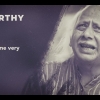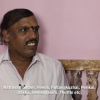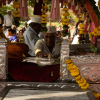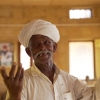Sharon Lowen is one of the leading Odissi performers today. She grew up in Detroit in the United States and was trained in puppetry and ballet very early in life. She also learned Manipuri under Minati Roy, and then, in 1975, came to India on a Fulbright scholarship to continue with her Manipuri training. Later she was trained in Mayurbanj Chau and Odissi. Lowen was the first woman solo performer of Maurbhanj Chau and played a major role in bringing international attention to the dance form. She has performed Odissi on national and international stages and has also choreographed and performed for films and Doordarshan. She has authored books titled Odissi and Dancing Phenomenon: Kelucharan Mohapatra.
Following is an edited excerpt from the conversation with Sharon Lowen conducted by Madhur Gupta in Delhi, 2018.
Madhur Gupta (MG): Tell us about your early life. You were born in Detroit and had a working mother who supported you to dance, not just dance, but also to learn arts. Tell us about your childhood.
Sharon Lowen (SL): I grew up in Detroit, Michigan. Detroit is a very interesting city, a city that had a great deal of support for multicultural, multi-ethnic activities and performances. It was a city that actually was very cosmopolitan, and I was very fortunate that my mother loved the arts. So, I was aware that there was a great world out there and I was curious, I was interested—I knew that I didn’t want to wait till I was old enough to travel. I took every workshop and opportunity that I could. By the time that I was thirteen, I realised that, as much as I loved my ballet class and loved modern dance, the commitment to be a professional dancer was more than what I was ready to take away from other things. And I loved everything else. When I went to the University of Michigan, I was interested in the arts, I was interested in Asia, and it is hard not to think what I had in mind. And I convinced the Honours College to let me apply to the Board of Directors to create my own undergraduate major, which I called Humanities, Fine Arts and Asian Studies. As this point I had been studying Manipuri dance with Minati Roy, she was Minati Basu when she was young, and I loved the Manipuri [dance form], I found it very lyrical—suits my personal style of dance. After some time, I was not only performing for birthdays, pujas, etc., but also could teach a group of Indian women in Minati’s absence.
I applied for the Fulbright scholarship to come to India. To apply for a Fulbright scholarship in dance, in those days, required making a film. I had to make a 16 mm black and white 5-minute film. I happened to be chatting with someone at a party. I was saying what was I going to do, and he said: Let’s split the cost of renting the camera, and I will shoot you and then I will have the camera for the rest of the day. And we did it. We got black curtains from somebody in the theatre department, and I went to Cleveland, where my teacher was, and I recorded her, and we made a film. And I got my Fulbright.
MG: In which year did you arrive in India?
SL: I got my Fulbright in 1972. I arrived in July, I believe 1973. I had been given affiliation with the Manipur Jawaharlal Nehru Academy. However, foreigners were not allowed in Manipur. So, when I arrived in the summer of 1973, I was affiliated not in Imphal, because of restrictions on foreigners, but at Triveni Kala Sangam, to study with Guru Singhajit Singh. He, of course, is a great artiste, greatly knowledgeable about the tradition. At that time there were no students, but he had the Triveni Ballet Company. So, I joined Triveni and was taking classes, and I lived in Bengali Market. One of the things about being a modern dancer in the era that I learned it is that a dancer is not just a dancer, a dancer is someone who needs to know as much as everything about as possible. You need to know music, you need to know art, you need to know philosophy, literature, architecture, etc. This is also there, as all know, in the Indian tradition. This was very much the intellectual framework of modern dance in the twentieth century in the West. My collaborations and interactions with the artistes were wonderful. During my first year studying Manipuri, Guru Kelucharan Mohapatra came to Triveni to give a workshop. And they did it on their open-air stage. I saw it and it was wonderful to see, but I had no interest in participating. At the end of the second year, Guru Kelucharan Mohapatra returned to Triveni to give a workshop again. This time I said: I am leaving India, I don’t know anything about a mainstream style that people in the West might be familiar with. I don’t know the difference between one mudra to another. I would like to take the workshop not to learn Odissi but to have a more academic understanding of another tradition.
MG: You had had 17 years of modern ballet training before you began to learn Indian dance. Then when you joined Kelu Babu’s first workshop, was it easier for you learn the steps?
SL: Yeah, Absolutely.
MG: Tell us about the workshop.
SL: When I joined the workshop—this is in early 1975—Kelu Babu said that I learned faster than anyone he had ever taught before. After two weeks, he had me demonstrating and helping with the beginning classes. The reason is that, first of all, in order to work in a turned out position, in chowk (a basic stance in Odissi), or in aramandandala (a basic stance in Bharatanatyam) or in any style where your legs are out—similarly in ballet and modern dance, it takes a dancer two years along with everything else like your rhythm, your upper body, everything else. But just to be able to work in a turned out position is going to take you two years to be able to do that. It is something you can’t immediately do. Also, the strength, flexibility, etc. Then the other thing is that in Odissi we are using the torso movement. So, first of all, you have to be conscious of our muscles, then you have to strengthen the muscles so they can move more. I had done jazz where you have isolation. So clearly the energy and the genre are different. It is not sharp, it is not syncopated, but you are using the training and muscles that one has. What I found most challenging was that I just spent a long time [doing Manipuri] where I was looking at my hands and not looking up, and so I wouldn’t even see the audience there. And I found it very difficult in Odissi to be looking out and projecting out, and seeing the imaginary audience or whatever. There is more of an internal gaze in—a more meditative gaze in Manipuri. But I feel that in a sense Manipuri and Bharatanatyam are equally distant from Odissi. So, in those days, there were Bharatanatyam dancers who were taking up Odissi, and their challenge—they had the clarity of footwork, they had the clarity of mudra (hand gestures in classical dance)—was that they were not able to get the lyricism, the body movements, that they could be in a tribhanga pose (characteristic standing pose in Odissi where the body will reflect three bends), but they were not able to move in it. Whereas, coming from Manipuri, the lyricism, the grace is there, but then one doesn’t have that energy, the sharpness of the footwork as in Odissi. So that was a challenge. In any case, I was just doing that. He taught me mangalacharan (invocation item), of course the first thing, and battu and saveri pallavi (items in a typical Odissi repertoire). I learned all that in two and a half months. Then Guruji asked Biteshu Rani, the Bharatanatyam daughter of the director of Triveni, to go with me to choose an appropriate sari to make into a costume, and then to take me to Ganapati, who was the master tailor to make the costume, thus giving me all these guidance—you must make costume, you must have the jewellery, you must make a recording of the music. So I recorded music which was quite remarkable.
When Guruji was teaching, you had this amazing atmosphere with more than a dozen dancers, everyone talking, speaking together, friendly, sharing—before I was in isolation, just one student, and that was as part of the ballet company. Here, it was this wonderful group, everybody talking, sharing … It was a wonderful atmosphere.
MG: Do you remember who were with you then?
SL: Sheela Raj was there, of course, Madhavi (Madhavi Mudgal) was there, also Kumkum. Guruji was, of course, as everyone knows, the most generous teacher. He had developed a pedagogy that in those days was absolutely unique, for being able to teach a large group of students at a time. Sanjukta Panigrahi and others had gone to Kalashektra [to learn Bharatanatyam], and when they returned, they explained the model of pedagogy of learning they followed there. He had then developed that for Odissi. But besides, developing on their model, he had an ability to not only demonstrate but also to communicate to each one in a large group what their adjustments were that were necessary.
MG: So, at the end of two and a half months you had learnt the basic steps— mangalacharan, battu and saveri. And you went back to the US?
SL: Right. When I came to India, it wasn’t my intention to be an Indian dancer. My idea was whatever I do will inform what I was going to do later.
From ‘75 to ‘78, I returned to India with my husband, and I was teaching at the American Embassy School, New Delhi. I was teaching creative drama and puppetry. I was teaching modern dance. I was organizing, several times a month, cultural programmes, by both Indian as well as international artistes. And I was continuing with my daily Manipuri classes, my weekend Chau classes, and whenever there were holidays, doing my Odissi. So that meant that the summer of ‘76, I went to Cuttack, Odissa, where Guruji lived at the time. It was the last year he was teaching at Kala Vikas Kendra. I attended his workshop and, in the afternoons, would go to his home for more study. And I was also going to Manipur in a month and, so, he preponed the date of the students’ performance so that I could be included. I performed mangalacharan with the entire group, I performed battu with a few others, and then saveri pallavi with a teacher form Kala Vikas Kendra, and another dancer who was a scholarship holder. And he said: Don’t tell anyone the short time that you actually studied because they won’t understand. And that was a wonderful experience. It was a wonderful, wonderful summer. I learnt a great deal. I think that was when I probably learnt vasantha pallavi, maybe lalithalavanga (both compositions in Odissi), I am not sure. Guruji was teaching at that time in Kolkata, Mumbai, etc., and did a lot of travelling. I also joined him in his travels several times. One memorable occasion was, after a workshop, he was going to Delhi, via Allahabad, where Sanjukta Panigrahi was performing. And he said: Come with me. I stopped over in Allahabad. In those two days, with Sanjukta, Raghunath Panigrahi and the team, I basically learnt so much about how an artiste interacts with your sponsors, with your musicians—I even learnt from Sanjukta the extra bobby pin that she would put in so that there won’t be any stray hairs . . . the way she twisted her hair—she was always so, so kind, so generous. I have so much love and affection for her and her family. There is nobody like her, you know. There is Guruji, there is Sanjukta, and then there is Kumkum Mohanty. After them, the rest.
MG: When you were dancing, after you finished your scholarship, what all dances were you doing—Manipuri, Chau and Odissi?
SL: I was doing everything. I started working on Yahi Madhava in Manipuri with Singhajit. But we never finished it. What happened was he was preoccupied with other things. And when he would come to class he would not remember whatever we had done the last time, and it was just kind of not really gaining any traction. Meanwhile, with Krishna Chandra Naik I was doing a lot in Chau.
The turning point about staying in India was something that many people are familiar with. A child’s school. Where will you be? When my daughter was six or seven years old, studying in first standard, ready for second, I had to make a decision. Then I decided, alright, if I am in India, number one, I will have live music. You can only create and grow when you have live music. I have opportunities to perform that require new choreography because of the place, the location, the event, etc., whether it is Tansen Music festival, whether it is Doordarshan, doing it in different languages, doing for Lord Hanuman, for Padmanabha Temple in Kerala, or doing in Bangladesh, or for Tagore festivals, etc. I decided I would like to stay in India.
MG: What were the challenges you faced as a foreigner performing Indian dance in India? Were you aware that there was a wall?
SL: I wasn’t aware. That was very fortunate. I always tell people naivety will get you further than courage and knowledge. There was no guidance. There was no mentoring. I had no mentor. I had no credibility. There were no opportunities. So, for instance, at Triveni, where I was a student of Manipuri, at Bharatiya Kala Kendra, where I was a student of Chau, neither institution included me in their annual student productions. I did not even know that they were going to happen. Who would have told me? It did not occur to me when I was looking at them: Oh, these are students, I, too, should be included. Today they include their foreign students. However, Kelu Babu was generous. There was a point when I was in Chicago, staying with one of my dear friends, and doing a programme at the University of Chicago. So I have a large trunk because I am doing Manipuri, Odissi and Chau. I also got nappies, baby bags and my daughter. And my friend lived upstairs, and she said: My back is not good, I can’t carry. I made a decision that day. I thought if I should ever be successful enough that there is someone to carry these things, I will do that. But after this I am doing only Odissi. It is simpler. You put on one costume, you change it at the interval, and you are done. It wasn’t that I stopped doing the other styles. But touring and all things became very difficult. That was in America. Then I found that the challenge of not knowing the language became a plus. So I found that other students might not know what the texts really meant, but they were learning the choreography and when they were performing, it may not be clear or articulate in what it actually means. I found that because I don’t know the language, I am working on connotations, denotations, what the era was, who the poet was, differences between Oriya and Sanskrit, talking to scholars, and so being able to try and understand it and feeling an awareness that I need to make it clear to the audience even if they are not following the text.













